Crew Photos – April 24th
GreenHab Report – April 25th
Crew 297 GreenHab Report 25-04-2024
GreenHab Officer: Sean Marquez
Environmental control:
– Heater on (set to 55F)
– Fan on (set to turn on at 94F; turn off at 82F)
Average temperatures: 83F
Hours of supplemental light: N/A
Daily water usage for crops: 4 gal
Daily water usage for research and/or other purposes: 0 gal
Water in Blue Tank: 161 gal
Time(s) of watering for crops: 14:20
Changes to crops: N/A
Narrative: The GreenHab atmospheric temperatures managed to stay below 100F completely on the automated fan system without the need for supplemental airflow from the tunnel system today, likely due to the cooler outdoor temperatures due to overcast. Today’s harvest was a record for Crew 297! And it provided an excellent basis for both lunch and dinner.
Harvest:
– 208g of cherry tomatoes
– 243g of red cabbage
– 43g of kale
– 6g of lettuce
– 45g of carrots
– 183g of cucumber
– 30g of green onion
– 11g of radish
Support/supplies needed: N/A
EVA Report – April 25th
Crew 297 EVA 16 Report 25-4-2024
EVA #16
Author: Pawel Sawicki
Purpose of EVA: This EVA concludes the human-interaction study from CU Boulder, where two cremates will use the User Interface to monitor and interact with Case, as it traverses and records imagery of the points of interest (areas on the way and surrounding the destination).
Start Time: 8:50 AM
End Time: 11:21 AM
Narrative: Drs. Storch and Sawicki ventured out far north to the Gateway to Lith this morning to locate an area suitable for Case to drive around. Although they did not find anything in the vicinity of Gateway to Lith for this purpose, they admired the views of this area. On the way back, an adequate area was indeed discovered and utilized for the human-research interaction study. Case performed well in its given task, requiring minimal human intervention. The robot was then driven manually to test its steep hill-traversing abilities. The equipment was gathered up and the crew returned home to the Hab.
Destination: Gateway to Lith
Coordinates: 12S 518283 4255681
Participants: Pawel Sawicki (Commander) and Matthew Storch (XO)
Road(s) and routes per MDRS Map: Cow Dung Road
Mode of travel: Opportunity
Sol Summary – April 24th
Crew 297 Sol Summary Report 24-04-2024
Sol: 10
Summary Title: The Martian Chronicles
Author’s name: Pawel Sawicki
Mission Status: Nominal
Sol Activity Summary:
This morning a portion of the crew woke up early to evade the impending hot weather and venture out on an EVA to Somerville Overlook. With the morning breeze assisting, the crew took the brisk walk from Opportunity to the overlook and admired the views. But of course, research was the main priority, and as such the crew went to work. Many samples and measurements were collected from the area, and on the way back Case was finally able to return to areas outside of the MDRS station.
Meanwhile, the later EVA crew, within the warming weather, was able to finally find the hidden NPS and return it safely to the Hab. The crew of two then set foot to Skyline Rim and investigated NPS digging sites along the way, testing the Martian surfaces for a qualitative assessment of ease of digging. This particular EVA broke a record for longest walking distance during Mission 297 – a Brobdingnagian 10 km!
Look Ahead Plan:
Tomorrow will be the last day involving multiple EVAs. The morning EVA will venture out to the Gateway of Lith and take Case out for its last stroll into Martian regolith. Case is expected to now be fully functional and should reliably take imagery of the area (with some expected intervention via crew manual driving). The second EVA will venture out to Somerville Overlook to scope areas for NPS digging. Back at the MDRS station, the crew will prepare the decommissioning process of the GreenHab for the season.
Anomalies in work:
Suit 11 (fan power substantially decreased mid-EVA): Battery was replaced but the air flow is still less than nominal. Inop’d for the current mission.
Weather:
Morning (data from 0900): calm winds (3 mph), chilly (59F), and sunny with clear skies
Noon: moderate winds (12 mph), warm (76F), and sunny with clear skies
Afternoon (1800): moderate winds (14 mph), hot (81F), and sunny with clear skies
Crew Physical Status: Overall crew health is nominal.
EVA: There were two EVAs today. The first EVA, involving Sarah and Pawel, successfully reached the Somerville Overlook and took gamma-ray spectrometer measurements along with samples. On the way back, near Compass Rock, the crew performed the human-interaction study with Case, though had to cut short due to time constraints. The second EVA was able to (finally) successfully locate the NPS and bring it back to the Hab safely. The crew also ventured to Skyline Rim and located many potential NPS digging locations on the way.
Reports to be filed:
Sol Summary
Journalist Report
GreenHab Report
Operations Report
EVA report (2 EVAs)
EVA request (2 EVAs)
EVALink Feedback Report
Support Requested: None requested.
EVA Report – April 24th
Crew 297 EVA 14 Report 24-4-2024
EVA #14
Author: Sarah Lamm
Purpose of EVA:To observe the orange region from orbit.
Start Time: 8:02 AM
End Time: 10:47 AM
Narrative: We arrived about 0.6 miles away from Somerville Overlook as Opportunity’s battery had dropped to 55%. From there we walked to Somerville Overlook to observe the orange region. It seems to have more silica present than previous locations. Seems to be chert that had been partially dyed orange. We also observed bedded layers of shale, silt, and what appeared to be chert. After we left Somerville Overlook, we went back to the intersection of Galileo Road and Watney Road to use the Case robot.
Destination: Somerville Overlook
Coordinates: 12S 521996 4253063
Participants:Pawel Sawicki (Commander) and Sarah Lamm (Geologist)
Road(s) and routes per MDRS Map:Cow Dung Road, Galileo Road
Mode of travel: Opportunity
Journalist Report – April 24th
Crew 297 – Janus 1 Journalist – David Laude
"The surface of Mars is a place of bare rock sculpted by wind, with canyons and valleys much deeper than the Grand Canyon on Earth." – Steven Squyres
Today’s Sol 10 brings with it a sense of urgency as Sol 12 will be our last for this team of researchers and explorers.
Curiosity carried the morning EVA team, Matt and Matt, to the exact coordinates for the NPS and it was recovered quickly, although it was hidden in an extremely challenging spot by the previous team. Around noon, they returned to the Hab and began their on-foot journey to Skyline Rim. By 12:40 they had reached the top of the ridge line behind MDRS, and continued with the long march across the Amazonis Planitia. They reached the Skyline Rim and proceeded with ground testing to determine the feasibility of burying the NPS in that region. After testing was completed, they headed back to the Hab.
Sarah and Pawel traveled to Somerville Overlook to observe the orange region.
The last of the crew members biographies to present is that of the Journalist/Engineer:
"David Laude was present for the memorable and impressive launches of Apollo 11, the first Space Shuttle and subsequent Shuttle night launches. He also met several lunar astronauts and like many others, dreamed about space exploration. David began a lifelong passion for electronics and space technology in elementary school. With a B.S. and a M. Eng. in Electrical Engineering, he designed integrated circuits for Harris Semiconductor (now Intersil), Ford Aerospace (now unknown), Ford Motor Company and Linear Technology Corporation (now Analog devices). David is currently retired from the work force and is a lifelong learner who enjoys working with talented people. He also has formal training in Anthropology and Archaeology. He is a member of The Planetary Society and a founding member of The Mars Society. His hobbies include radio controlled airplanes, electronics, musical instrument synthesizers, music composition and antique radio restoration. Utah, with its stark beauty and remote areas, is one of his favorite states. He previously served as a crew member at MDRS on Crews 80, 181, 228 and 265 in the roles of commander, executive officer and engineer."
Crew 297 End-Mission Research Report – Apr262024
[title End-Mission Research Report – April 26th]
[category science-report]
End-of-Mission Research Report – Crew 297
Summary of Crew Research Projects:
Title: Advancing Planetary Mineralogical Analysis: Evaluating the Usability of Portable Gamma Ray Spectroscopy during Martian Operations
Principal Investigator: Sarah Lamm
Research Summary: Mars has been studied from orbit by gamma-ray spectrometers with great success since the 2001 Mars Odyssey Orbiter, which is still running to this day. This project is showing the practicality of a portable handheld version. This research is testing the practicality and feasibility of a portable Gamma-Ray Spectrometer in the field.
For this study we are using a RS-125 Gamma-Ray Spectrometer, which is 25.9x 8.1x 9.1cm at 2 kg, with a rubberized grip, and dust protected, one button operation, and sound loud enough to be heard in a spacesuit helmet over a fan. The assay was set at the standard 120 seconds, reading wt% of radioactive potassium (K), and ppm of uranium (U) and thorium (Th).
Stop 1: At 12S 518065 4250003 we ran initial Gamma-Ray Spectrometer readings of the tan and red regolith. The mounds of this region are unconsolidated fine grain clay minerals with desiccation cracks. The potassium amount in the red regolith was about double of the potassium in the tan region. Based on the Th/U ratio, it shows that the red regolith was oxidized, which makes sense based on the other observations and the red coloring is likely from iron oxides-stained clay minerals. The Th/K ratio indicates that the clay minerals inside both regolith are likely smectite.
Stop 2: At Robert’s Rock Garden (12S 518278 4249467), further south than Stop 1, we observed conglomerates that were from a higher layer, that had fallen due to lower layers being eroded away. The conglomerates are poorly sorted from gravel to sand size, clast supported, and likely a silica matrix. The K, U, and Th amounts were significantly below the average amount in the previous region.
Stop 3: Further south from Robert’s Rock Garden at 12S 518819 4248714, we found an area that’s regolith looked redder from orbit than the surrounding region. Here we found red and white regolith. The red regolith had larger desiccation cracks than the white regolith. The K in the red regolith was more than double the white, indicating that the K was likely leached out. The red regolith in this region did have a slightly higher Th/U ratio than the red regolith at Stop #1 indicating that this area likely had higher Redox change.
Stop 4: The grey unit (12S 516189 4254637) Northwest of the Hab, just south of the sea of shells, did have more uranium than the previous units, that being said the amounts were in the average range between 3-5 ppm. The K and Th amounts were also average.
Stop 5: The grey rocks north of the Hab (12S 518272 4251168) were depleted in K, U, and Th.
From this study, we tested the practicality of using gamma-ray spectrometers for field use as an astronaut. The mass of this portable gamma-ray spectrometer is minimal enough that it should have little impact on the payload capacity for geological samples that an astronaut could carry. This spectrometer requires only two minutes per assay, which might be lengthy for astronauts with other specific EVA tasks but is reasonable for a geologist to make and record observations about most geological units. The amount of bending over to set the spectrometer and read the results, and then picking it up afterward, may vary depending on the geological formation. However, due to its small size and mass, it should not impose excessive physical exertion. The gamma-ray spectrometer is easily operable with gloves on, functioning as a one-button system that changes functions and menu options based on how long the button is pressed. It is small and durable enough to be operated with gloves and a space suit, and not cumbersome when hiking up hills and down into dried streambeds.
To effectively utilize the portable Gamma-ray spectrometer during field missions, astronauts require minimal training and expertise. The operation of the portable gamma-ray spectrometer is straightforward, making it accessible for any astronaut. Therefore, less than 10 minutes of training is needed for basic usage. The primary challenge lies in choosing optimal geological formations and interpreting the results. Any astronaut could be trained in basic or preliminary interpretation since there are only three elements to consider. However, the formal interpretation should be handled by specialists. Overall, the gamma-ray spectrometer could be successfully used by astronauts with minimal instrumentation and geological training.
The portable Gamma-ray spectrometer enables real-time decision-making and direct extravehicular activities (EVAs), especially since gamma-ray spectroscopy can differentiate between samples that appear visually similar but differ in radioactive trace elemental amount. The significant distance between Mars and Earth results in a 6–40-minute data latency, making real-time direction from mission control impractical. Therefore, Mars astronauts likely possess a greater degree of autonomy in conducting measurements and collecting samples compared to lunar astronauts. Consequently, Mars astronauts require instruments that can provide rapid assessment and preliminary interpretations to guide their fieldwork, a role that gamma-ray spectroscopy can effectively fulfill.
From this perspective, the advantages of a handheld gamma-ray spectrometer outweigh the disadvantages. These devices provide rapid assays of radioactive material in the field, enabling the determination of lithology, past aqueous events, and even assessing risks such as Radon gas exposure for astronauts. Future studies should compare handheld or portable scientific instruments like Raman, IR, and LIBS with handheld gamma-ray spectrometers to determine the most effective and useful tool. Ultimately, a gamma-ray spectrometer is a practical instrument that astronauts could seriously consider taking on trips to Mars.
Title: Simulated Deployment of a Nuclear Power System: Logistics and Operational Challenges
Principal Investigator: Matthew Lynch
Research Summary: The goal of this project was to simulate the collection & deployment of an inert nuclear power system (NPS) on Mars by a crew of astronauts. To achieve this objective, the project was divided into 3 core tasks: 1) placing the NPS in a realistic landing site reachable from the Hab, but simulate inaccuracies in landing by giving the recovery crew incorrect landing coordinates, 2) locating and recovering the NPS by utilizing a variety of search methods in the expected area, and 3) determine appropriate excavation terrain to bury the NPS and determine expected human digging rates. Nine EVAs in total were done for this project and every crew member participated at least twice. Our combined search areas totaled to 1.75 square km (431 acres). We were successful in finding the NPS 5 out of 6 times within our given time limit, with the most successful search strategy being the "high-point" method. Our one unsuccessful attempt at finding the NPS was a particularly challenging hiding spot that was chosen to thwart the "high-point" search strategy. Several areas were scouted to potentially entomb the NPS, with two ultimately being selected to perform full excavation experiments at. These two spots were chosen as they exhibited a variety of contrasting ground features, resulting in an expected difference in digging rates. This was confirmed experimentally as the near ideal excavation site resulting in a material removal rate of ~53 cubic feet per hour, while the significantly more challenging location resulting in a rate of ~30 cubic feet an hour. Weather, tools, and digging procedures were kept constant between these two locations, so we are confident that this 43% decrease in removal rate is primarily attributed to the terrain conditions.
As we have demonstrated this project was a success and has resulted in valuable information for the deployment of a NPS on Mars. Furthermore, many of the findings here can be applied to other tasks such as search & rescue efforts, excavation for base construction, and a better understanding of the terrain surrounding MDRS.
Title: A Toolset for Shared and Long-term Document Management and IT Operations
Principal Investigators: Sean Marquez & Matthew Storch
Research Summary: The WIDGIT project got off to a fast start, as Matt S. & Sean were able to accomplish all of the following during our first day at MDRS:
set up a local WiFi network 100% independent of the Internet
get the WIDGIT server configured on that independent network, and accessible via NoMachine (as the monitor and keyboard we have available are only useful for rudimentary work)
finish the configuration of 3 workspace sessions for crewmembers that did not have adequate hardware to run the workspace locally on their own laptops
clone the notes repo for each of the server-based workspaces
At that point WIDGIT was in a usable state. However, as the mission got into full swing, the crew focused on EVAs and various other required tasks, and were also dealing with several power outages per day. Therefore we could not find enough time to conduct the crew’s WIDGIT training until Sol 4. Even then, only two crew members fully participated in the training while a third participated partially.
From Sol 2, the two PIs were using the system. In particular, the GreenHab Officer was pushing GreenHab reports into Dendron. The MDRS Handbook has also been incorporated into Dendron except for the Appendix.
From Sol 5, two other crew members were using the system for limited purposes. The main additional use cases were to use WIDGIT to write the Mid-mission and Final Summary Reports, thereby demonstrating that collaborative workflows can be conveniently accomplished on a purely local network.
The PIs had originally envisioned additional use cases for WIDGIT, such as:
[FPrime] running the FPrime data collection system for monitoring environmental conditions in the GreenHab on the same fully local network
[Notes] other crew members using WIDGIT for taking and organizing research notes
Other crew members did not actually use WIDGIT for taking notes. The reality is that WIDGIT has more overhead in terms of both learning and operations than conventional internet-based tools, and the crew had an ambitious schedule for EVAs and other research projects. In addition, many other activities (cooking, cleaning, etc. while dealing with power outages) took more time than anticipated, further dampening enthusiasm for using the tools. On the other hand, WiFi was continuously available, meaning that WIDGIT was competing with Google Drive and Google Docs, and the latter provided an irresistible level of convenience for a busy crew.
Based on these results, the PIs will consider alternative methods of collaboration and note-taking that require less learning and provide a more user-friendly experience, for use in such cases where the users are not programmers. For groups of users who are primarily programmers, we found nothing to contradict the thesis that the Git + Markdown + Dendron approach is effective. Also, for any group of users that rely on complex toolsets, a streamed workspace image built on immutable-infrastructure-as-code is a very useful mechanism.
Title: MDRS IOT-Assisted Data Collection Using OSHW & OSS
Principal Investigator: Sean Marquez
Research Summary: Progress and development efforts were made on implementing the FPrime data collection system for use in collecting environnmental data in the GreenHab at MDRS. The minimal characteristic components have been demonstrated, specifically with the open-source fprime-baremetal-reference, example Arduino sketches for the BME680 environmental sensor, and the SGP30 air quality sensor (developed by Adafruit). Unfortunately, the code implemented thus far using the FPrime flight software / embedded systems framework still has bugs to be worked out before a technology readiness level (TRL) 4 proof-of-concept can be fully demonstrated.
Title: Use of Sonar for Measuring Water Tank Depth
Principal Investigator: David Laude
Description: This research project would provide the means to accurately measure the amount of drop in static tank water level via an electronic sonar range finder device.
Objectives: This research project would replace acquiring the distance of the static tank opening to the water surface with a ruler, for determining the remaining volume of water, to acquiring via an electronic sonar (ultrasonic) range finder device, specifically an LV-MaxSonar. The volume can subsequently be determined by the sensor’s output signal measured with a digital voltmeter (DVM) and then entered into a spreadsheet formula that calculates daily water usage and water remaining.
Research Summary: Initial testing on a nearly full static tank did expose a problem. Inside the tank, near the top opening, there is a wide hose that spans across much of the top area. This hose interferes with measurement as one would expect. However, the hose lays mostly in the tank half closest to the Hab and placement of the device near the opposite side is all that’s needed for an accurate reading. As the tank lowers, more measurements will be needed to determine if accurate to near empty. Initially I had thought to further develop it, for a subsequent crew assignment, to indicate gallons remaining in a three digit display. However, now seeing the water usage spreadsheet with its input in units of inches, and output in gallons and average use, I believe it best for the final device to output in inches. This would also make it usable with other different sized tanks, assuming different formula parameters. Measurements of water level down to 28 inches below the rim of the static tank have been performed and compared to measurement by ruler. Accuracy has been consistent with that of ruler based measurements, to within a few percent, and therefore of sufficient accuracy. However, as the water lowered more of the hose and then the pump was exposed above water and erratic measurement results occurred. The pump with attached hose were slid several inches close to the side of the tank to facilitate accurate measurements. Future use of this device by others needs to include a notice of this potential issue. The device was also tested on the GreenHab water tank. Down to its last measured level of 24”, it was accurate when compared to a tape measure. I do have concern that at lower depths the device could become confused, due to the narrowness of the tank.
Title: Robot Competency Self-Assessment at MDRS
Principal Investigator: Nicholas Conlon (at CU Boulder, on Earth – Pawel Sawicki supervising project at MDRS)
Research Summary: The Human-Robot Interaction study from the COHRINT Laboratory to understand the relationship between astronauts and self-assessing robots was a success, despite suffering many early setbacks. More specifically, the achieved primary goal of this study was to understand how future astronauts involved with robotic applications rely on telemetry, map data, and intuition in order to infer how competent a robot will be within a given environment. The Sojourner-sized robot, named Case, functioned through the use of ground support equipment (GSE) consisting of a WiFi network router, a laptop, and a Reach RS2 GNSS Receiver.
Case was involved in six EVAs, totaling 10.5 hours. Five of these EVAs used the robot successfully, with one (EVA #8 on Sol 6) running into network connectivity issues. Another anomaly that occurred and was resolved during the mission was a non-functioning first-person view (FPV) camera (not used to meet any of this research’s objectives), which was not working due to an ssh public key authentication error on the connected Raspberry Pi. This anomaly was resolved on Sol 9, utilizing payload support from the CU Boulder team back on Earth. The first EVA that Case was on, EVA #5 on Sol 4, involved fairly nominal operation of the rover, minus the aforementioned non-functioning FPV. Although the rover would occasionally not reach Points of Interest (POI), this was easily overcome with manual override driving by Sawicki. Using synchronized manual and automated driving sequence, an adequate portion of the EVA area was captured on Case’s GoPro which will be post-processed post-mission to develop "Street view"-like imagery. EVA #10 on Sol 7 involved Laude as the robot controller. This EVA was performed locally from the RAM, as transporting CASE requires a noteworthy amount of heavy GSE. While Case’s paths to destinations were certainly mysterious at times during EVA #10, it was always able to reach the designated POI and avoid obstacles. Laude also took over manually to avoid obstacles, test Case’s range of operation, and perform the precise maneuver of bringing Case up the RAM’s ramps. EVA #13 on Sol 9 also conducted testing from around the Hab, specifically from the ScienceDome, until trust could be established with the reliability of Case. During this EVA, both Marquez and Lynch operated the robot. Marquez and Sawicki recreated the hexadecimal message scene from The Martian at this point and established confidence in the functionality of the onboard inertial measurement unit (which had shown transient problems in prior EVAs). The trust established in Case from EVAs #10 and #13, enabled the crew to utilize the robot once again out in the field. During EVA #14 and #16, where Lamm and Storch operated the robot, respectively, with relatively successful route maneuvering displayed from the robot. During these routes, Case would need to re-compute its next steps very often, but would certainly eventually make its way to the prescribed point-of-interests.
The crew also demonstrated the customizability of Case, incorporating their own Geiger-Muller Counter to the top of the robot’s chassis. From these readings, the highest count rate observed was at 34 CPM and dose rate indications at 0.221 μSv/h, in line with safe and nominal radiation levels.
Every crew member spent time operating and monitoring Case within various EVA configurations and filled out pre- and post- mission surveys related to its use. These results, along with corresponding logged telemetry of the robots movements and displayed assessment status, will be investigated further by the COHRINT Lab back in Boulder on Earth at a further date.
Mission Summary – April 26th
Mission Summary
Mission: 297
Dates: April 15 – April 26, 2024
Author: Pawel Sawicki (Commander)
“Welcome to Mars” was the first thing the 297th Mars Desert Research Station crew, named
Janus I, heard when their mission commenced shortly after noon on April 15th. With Janus I being the Roman god of duality, transitions, and beginnings, this opening exclamation by
Mission Support was a fitting ribbon-cutting for a crew where five out of 6 members had never
traversed the analog Martian regolith before.
With such a novel crew, the first handful of sols were especially vital in familiarizing ourselves
with the nominal procedures of the Station. During the beginning timeframe of the mission, the crew made sure to become acquainted with the expected duties of their roles, layout of the
various Station facilities, and functionality of the EVA suits and rovers. This first set of sols also
established the groundwork for the various research projects, with initial objectives completed
related to all projects.
The Janus I crew quickly became accustomed to their Martian home, as the sols gradually
became more habitual and routine. Mornings were often filled with EVAs and afternoons
consisted of report writing, card games (Hanabi, Uno, and President), music courtesy of Dave,
space-themed movies, and a bi-weekly Thursday trivia night. It also turned out that the crew
was composed of world-class cryodessication chefs, albeit they were the only chefs on this
planet. During the 12-sol mission, meals composed of an assortment of cuisines were artfully
crafted: ceviche, crepes, casserole, Japanese curry dish, Jambalaya, Southwestern beans and
rice, spaghetti, soupe au fromage et aux légumes, soy peanut couscous, shoyu ramen, and
vegetable stir fry.
Many of these meals utilized the available GreenHab resources. During the mission, the
GreenHab officer harvested a veritable cornucopia of vegetables: radishes (681 g), cherry
tomatoes (534 g), cucumbers (471 g), red cabbage (309 g), kale (220 g), green onions (53 g),
carrots (45 g), parsley (34 g), sage (12 g), lettuce (6 g), thyme (5 g), and rosemary (3g). Such a plethora of vegetables came as a result of being the last crew to utilize the GreenHab this
season, a privilege which also came with the expected responsibility of tearing down the
GreenHab on our last day. Maintaining the GreenHab during its last few weeks of the season
did not come without added difficulties for the GHO. Due to frequent power shortages, the
automation functionality of the fan was unreliable, resulting in required manual intervention to
maintain the GreenHab internal temperature within a desirable range.
Anomalies were not just present in the GreenHab. As expected of any space station,
maintenance was a primary responsibility of the Crew Engineer – a duty at which they excelled. During the 12-sol mission, the Crew Engineer repaired Suit 2 (stuck valve), Suit 3 (loose
power connection), Suit 4 (missing cable ring), Suit 5 (ventilation electrical connection), Suit 11
(poor battery life), replaced Hab Tunnel zip ties, and tightened key switches on all 4 rovers.
Apart from corrective maintenance, the engineer made sure that the Hab was functioning
nominally by monitoring and emptying the toilet, calculating water levels, and inspecting the
entirety of the station’s facilities in the midst of uncertain power supply.
While the crew masterfully executed their positional duties, they never let up on successfully
conducting their research. Janus I investigated many sub-disciplines of science and
engineering, specifically geological field spectroscopy, operations of nuclear power systems,
developing smart sensor-based systems, and Martian-appropriate advancements in IT, and
were participants in research projects pertaining to isolated, confined, and extreme
environments and human-robotic interactions. With three of these projects relying heavily on
EVAs for expanding the sample size, the Janus I crew conducted an astounding total of 18
EVAs, which lasted a cumulative 42 hours. For more insight into the many achieved research
objectives of Mission 297, it is recommended to read the End-of-Mission Research Report.
As the T- minus clock winds down for the return launch, with a heavy-heart we say goodbye to
our Martian home of 12-sols and look forward to hearing “Welcome back to Earth”.
Journalist Report – April 26th
"A time would come when Men should be able to stretch out their Eyes …. they should see the Planets like our Earth." Christropher Wren, Inauguration Speech, Gresham College, 1657
Today’s only, and last, EVA took place mid-day. Its goal was to geologically observe the region that appears purple from orbit. This location has also been referred to as Purple Mountain. Wind conditions escalated as the Crew of Sarah, Pawel, Matt and Matt drove Opportunity and Curiosity to North Ridge. They walked to the southwest part of North Ridge and on the way up observed green shale, various colors of regolith, and tan sandstone. They were able to observe large areas of sandstone that had fallen from the higher layers. On the way back, while in Rovers, a light rain graced the final EVA.
Tomorrow, after 12 days of rigorous simulation, our crew of six will emerge from our Mars habitat. Inside the habitat our crew navigated through challenges, from managing limited resources to maintaining physical and mental well-being. Each crew member carried with them valuable lessons and experiences, ready to contribute to the ongoing quest for space exploration.
We, Crew 297, bid farewell to life on Mars, and to a rare, fortunate and productive two weeks at MDRS. We wish to thank all MDRS personnel for their support and to thank the state of Utah for the use of this unique Marscape on Earth.
Dave Laude
Crew 297 Journalist/Engineer





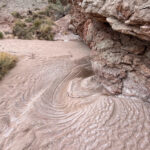

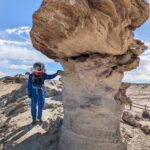
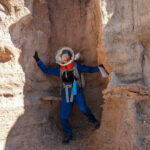




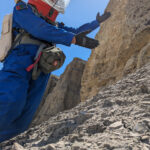
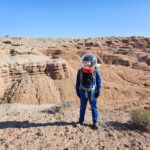


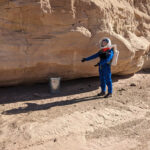
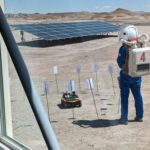

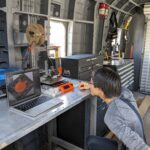
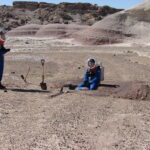
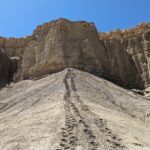
You must be logged in to post a comment.